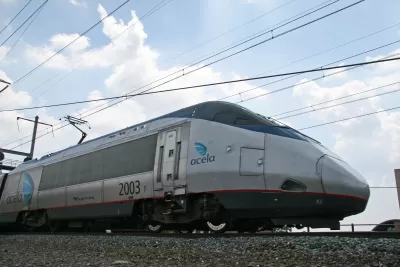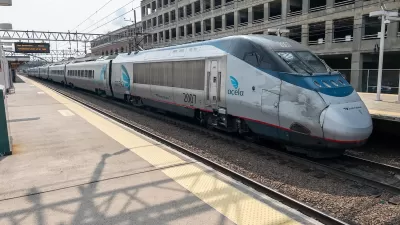Changes to boarding platforms and a switch to electric trains could improve U.S. passenger rail service without the added cost of high-speed rail.

A new report by the NYU Marron Institute’s Transit Costs Project by researcher Nolan Hicks suggests a “suite of targeted improvements” dubbed the “momentum” framework that could speed up passenger rail service in the United States by up to 30 percent — without high-speed rail.
As Benjamin Schneider explains in Bloomberg CityLab, “Hicks’ Momentum approach achieves its time savings not so much from increasing top speeds, but from reducing the “dead time” trains spend idling at stops and getting back up to speed again.” According to Hicks, U.S. trains spend a lot of time at stops due to low boarding platforms that extend boarding time for passengers and diesel locomotives that take longer to start up and get up to speed.
“The first intervention Hicks recommends is high-level boarding platforms. This ADA-accessible design allows passengers to walk or roll aboard without alighting any stairs. It also enables a train car design with wider doors, so more people can get on and off more quickly.” More importantly, electrified trains would accelerate at twice the rate of diesel locomotives, letting trains travel at maximum speed for more of the trip.
“In effect, Hicks is calling for a national rail network built up to the standards of the Northeast Corridor — not a world-class high-speed rail line, but a popular, profitable route that dominates the travel market in its region.” These upgrades could be more attainable for U.S. rail markets, but obstacles such as shared tracks with freight lines and NIMBY resistance to electrical wires and infrastructure remain.
FULL STORY: The Secret Formula for Faster Trains

Planetizen Federal Action Tracker
A weekly monitor of how Trump’s orders and actions are impacting planners and planning in America.

Congressman Proposes Bill to Rename DC Metro “Trump Train”
The Make Autorail Great Again Act would withhold federal funding to the system until the Washington Metropolitan Area Transit Authority (WMATA), rebrands as the Washington Metropolitan Authority for Greater Access (WMAGA).

The Simple Legislative Tool Transforming Vacant Downtowns
In California, Michigan and Georgia, an easy win is bringing dollars — and delight — back to city centers.

The States Losing Rural Delivery Rooms at an Alarming Pace
In some states, as few as 9% of rural hospitals still deliver babies. As a result, rising pre-term births, no adequate pre-term care and harrowing close calls are a growing reality.

The Small South Asian Republic Going all in on EVs
Thanks to one simple policy change less than five years ago, 65% of new cars in this Himalayan country are now electric.

DC Backpedals on Bike Lane Protection, Swaps Barriers for Paint
Citing aesthetic concerns, the city is removing the concrete barriers and flexposts that once separated Arizona Avenue cyclists from motor vehicles.
Urban Design for Planners 1: Software Tools
This six-course series explores essential urban design concepts using open source software and equips planners with the tools they need to participate fully in the urban design process.
Planning for Universal Design
Learn the tools for implementing Universal Design in planning regulations.
Smith Gee Studio
City of Charlotte
City of Camden Redevelopment Agency
City of Astoria
Transportation Research & Education Center (TREC) at Portland State University
US High Speed Rail Association
City of Camden Redevelopment Agency
Municipality of Princeton (NJ)





























